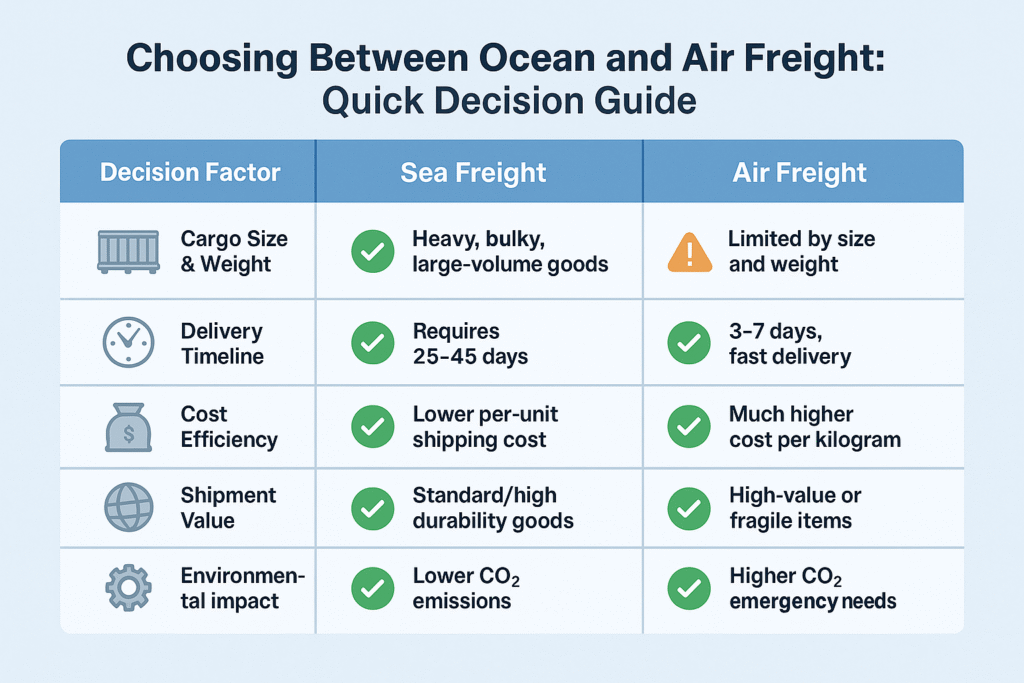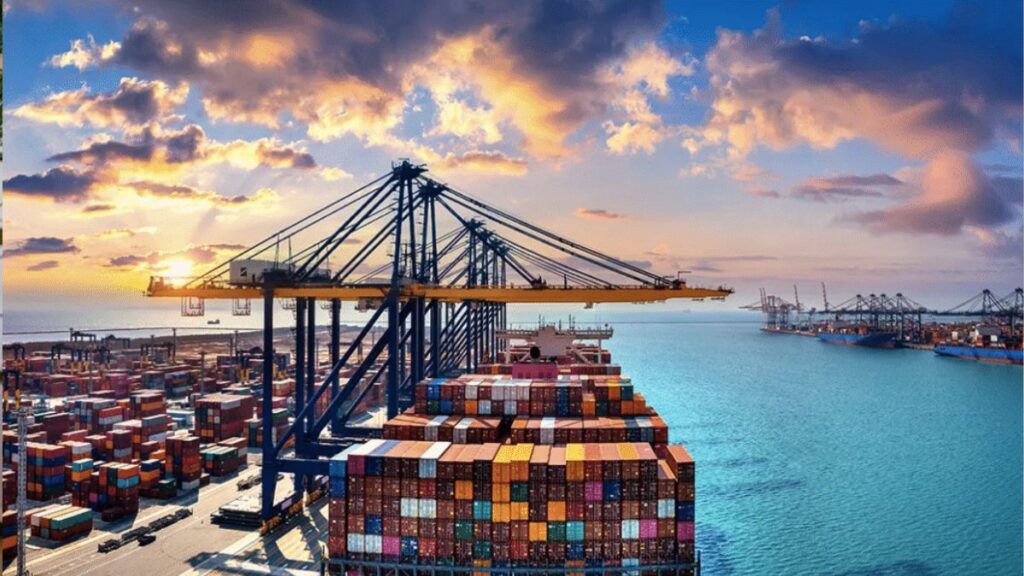Why Your Freight Choice Can Make or Break Your Business
Imagine this: you’ve spent months developing a new product, your marketing is ready, customers are waiting—and then your shipment gets stuck in transit. The sales season slips by, and with it, your profit. ocean freight and air freight.
In international trade, choosing between ocean freight and air freight isn’t just a logistics decision. It directly impacts your costs, timelines, customer trust—and ultimately, your bottom line.
In this guide, we’ll help you make smarter choices by breaking down when sea shipping makes the most sense, so you can ship not just faster, but better.
Ocean Freight: Why It’s Still the Backbone of Global Trade
Ocean freight remains the workhorse of global trade, especially for businesses handling Shipping from China to USA. Despite the rise of faster options, more than 90% of global trade volume still travels by sea.
Why?
Key Strengths of Sea Freight:
- Cost Efficiency at Scale: Per-unit shipping costs are much lower, especially for bulk or heavy goods.
- Ideal for Large, Heavy, and Oversized Cargo: Machinery, furniture, and manufacturing supplies all fit well into container shipping.
- Lower Carbon Footprint: According to the International Maritime Organization (IMO), ocean freight emits up to 30 times less CO₂ per ton-kilometer than air freight.
- Established Global Network: Major ports like Shanghai, Shenzhen, Los Angeles, and New York operate around predictable schedules.
But sea freight isn’t without its challenges. If you choose it blindly, you might encounter serious delays or added complexity.

The Hidden Costs of Sea Freight: What You Must Prepare For
While ocean shipping saves money upfront, there are risks to manage:
Challenges You Shouldn’t Ignore:
- Slower Transit Times: Shipping from China to the USA can take 25–45 days depending on the route, customs processing, and peak season congestion.
- Greater Risk of Delays: Weather disruptions, port congestion, or customs inspections can unexpectedly stretch your timeline.
- Complex Port Handling: Moving goods from port to warehouse often requires strong coordination with trucking and customs brokers.
Pro Tip:
If you’re relying on sea freight, always build in a time buffer—especially during peak seasons like Chinese New Year or the Christmas rush.
Air Freight: When Speed Is Worth the Investment
If sea freight wins on cost and scale, air freight wins on one thing: speed.
When you have tight launch dates, high-value products, or perishable goods, air shipping can protect your revenue, even with the higher cost.
Key Strengths of Air Freight:
- Lightning-Fast Delivery: 3–7 days from China to the U.S.—perfect for urgent shipments.
- High Reliability and Security: Air cargo is handled more carefully and tracked more closely, reducing risks for fragile or valuable goods.
- Ideal for Seasonal and Perishable Products: Fresh foods, pharmaceutical products, and time-sensitive fashion collections often depend on air freight.
Real-World Example:
A fashion brand launching a limited-edition sneaker collection had just two weeks to meet a holiday deadline.
Switching from sea freight to air freight increased shipping costs by 35%, but allowed them to launch on time—resulting in an extra $120,000 in seasonal revenue.
Without it, the entire campaign would have failed.
Choosing Smartly: 4 Key Questions to Guide Your Decision
Choosing between sea freight and air freight shouldn’t be based on cost alone.
Here are four smart questions to ask before you decide:
- What Are You Shipping?
- Bulky, heavy, or non-urgent goods → Sea freight
- Lightweight, valuable, or fragile goods → Air freight
- How Urgent Is Your Delivery?
- Hard launch deadlines or limited shelf life → Air freight
- Flexible schedules with weeks of lead time → Sea freight
- What’s Your Budget?
- Tight cost control needed → Sea freight (if you want to estimate the price, check typical shipping rates and schedules)
- Willing to invest in speed to secure revenue → Air freight
- How Flexible Is Your Supply Chain?
- Regular, large orders → Plan ahead with sea freight
- Small, frequent, just-in-time orders → Mix in air freight as needed
Bonus Tip:
Don’t just compare quotes. Always evaluate the total landed cost, including delays, stockouts, or lost sales opportunities.

When Sea Freight Is Your Best Move
While air freight is unbeatable for urgent needs, sea freight often delivers long-term strategic advantages.
Sea Freight Makes Sense When:
- Your cargo is heavy or bulky (machinery, furniture, large inventories)
- You need tight cost control for profitability
- You have flexible timelines and can plan 30–45 days ahead
- You value lower environmental impact to support brand sustainability goals
Remember:
Sea freight isn’t about being slow—it’s about being strategically planned slow.
Bonus: Common Pitfalls and How to Avoid Them
Even seasoned importers sometimes trip up. Here’s how you can avoid common mistakes:
Underestimating Lead Time
Don’t assume sea shipments will be fast. Build in buffer time, especially around holidays.
Choosing Based on Cost Alone
Missing a critical delivery window often costs far more than the savings on freight.
Skipping Cargo Insurance
Longer transit times mean greater exposure to damage or loss. Always insure your ocean shipments.
Smart shipping isn’t about getting lucky—it’s about planning for the real-world risks.
Conclusion: Ship Smarter, Save Bigger
Choosing between ocean and air freight isn’t just a cost calculation—it’s a strategic decision that can define your speed to market, cost control, and customer satisfaction.
By understanding your cargo type, timeline flexibility, and long-term goals, you can make better shipping choices that align with your business priorities.
Many importers today are rethinking their logistics strategies, blending air and sea freight for greater agility and resilience. Whichever path you choose, staying informed is the key.
Want to stay ahead of changing freight rates, port conditions, and transit times?
Resources like GortoFreight offer up-to-date guides, shipping calculators, and planning tools to help you make smarter logistics decisions.







